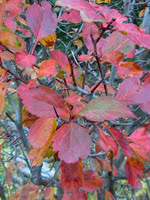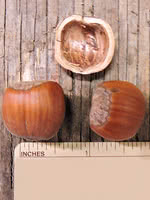Mon-Fri 9am - 5pm Mountain time
Black Hawthorn vs Andrew Hazelnut
Crataegus douglasii
Corylus heterophylla Het 1
NOT AVAILABLE THIS SEASON - MIGHT RETURN
NOT AVAILABLE THIS SEASON - MIGHT RETURN
Black Hawthorn is a versatile plant that is native to wetlands and other areas with moist soils, but can also tolerate dry soils. This plant can be grown as a short shrub, or a tree reaching 30 feet tall.
Black Hawthorn is valued for erosion control and attracting pollinators. It also makes an attractive flowering ornamental that can be planted as a specimen or pruned as a hedge. It is commonly used in shelterbelts.
Andrew Hazelnut is a northern cultivar that is grown specifically for its cold hardiness. Typically, hazelnuts produce smaller nuts in colder climates, but for Andrew Hazelnut, this is not the case.
This hybrid variety is incredibly productive, growing medium sized nuts that ripen in late August. Pair with another Andrew or Aldara Hazelnut for cross pollination to occur.
The edible nuts can be eaten fresh, used in baking, and will make a beautiful hedge. Andrew Hazelnut is also eastern filbert blight resistant.
Note: You want more than one hazelnut to improve yields.

